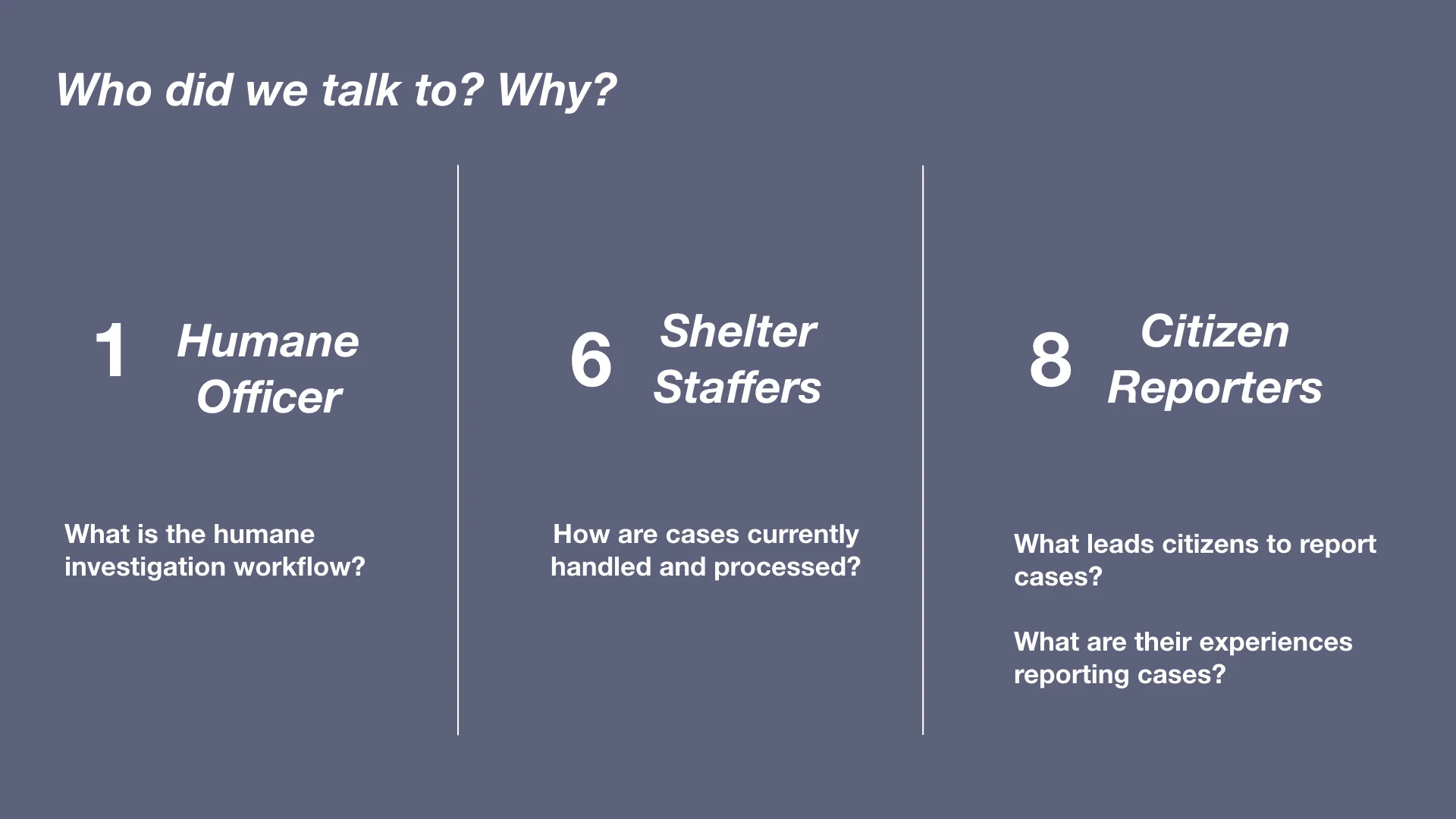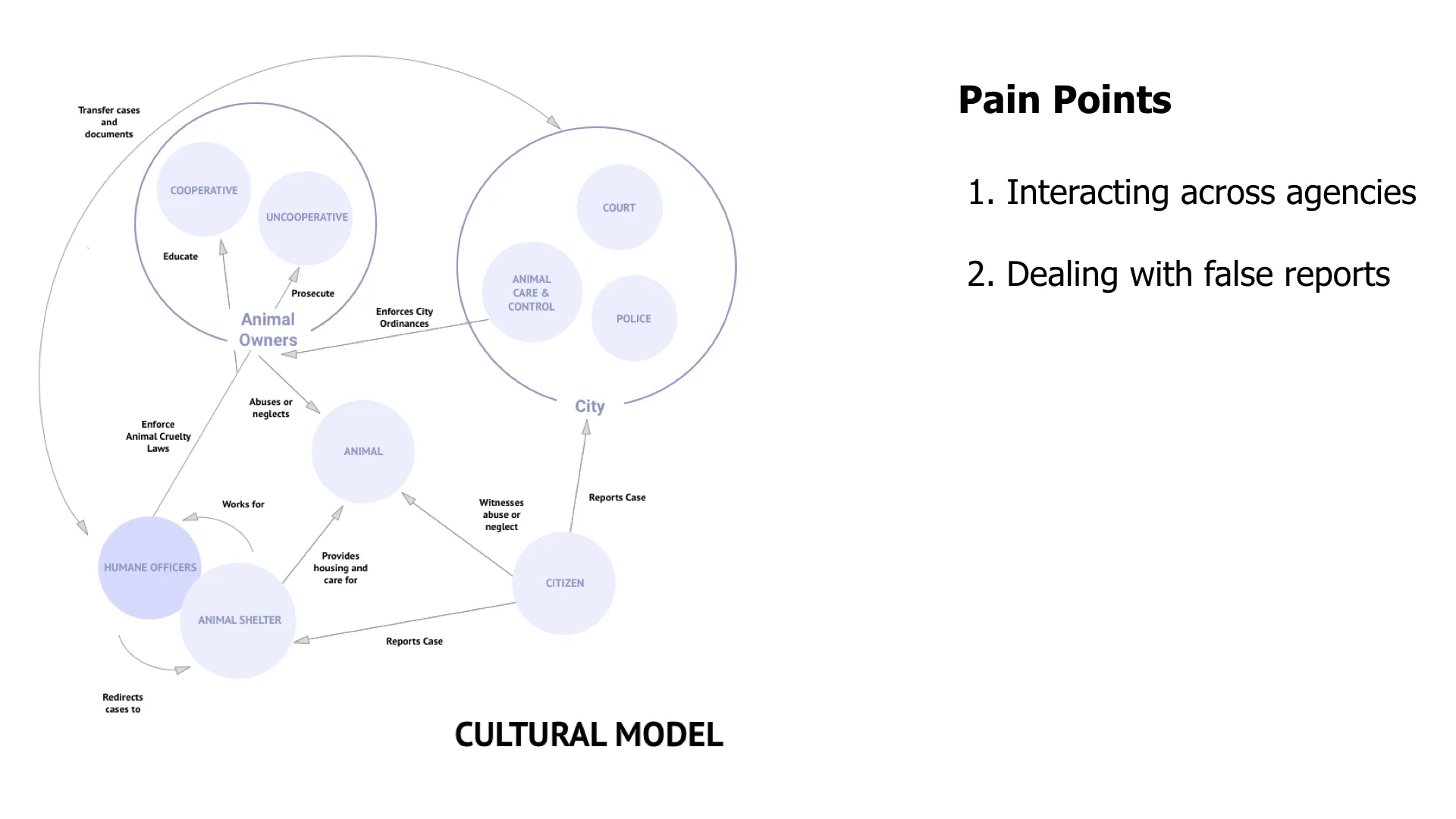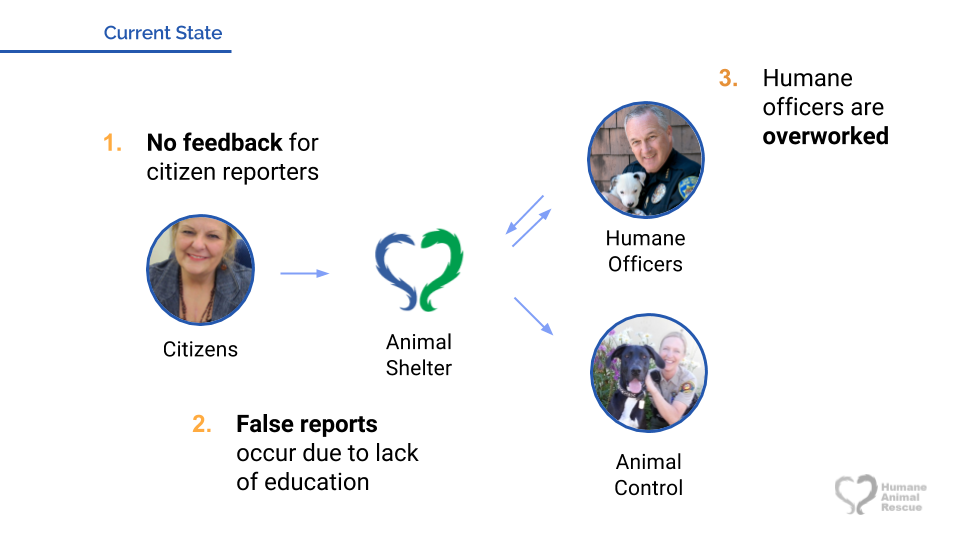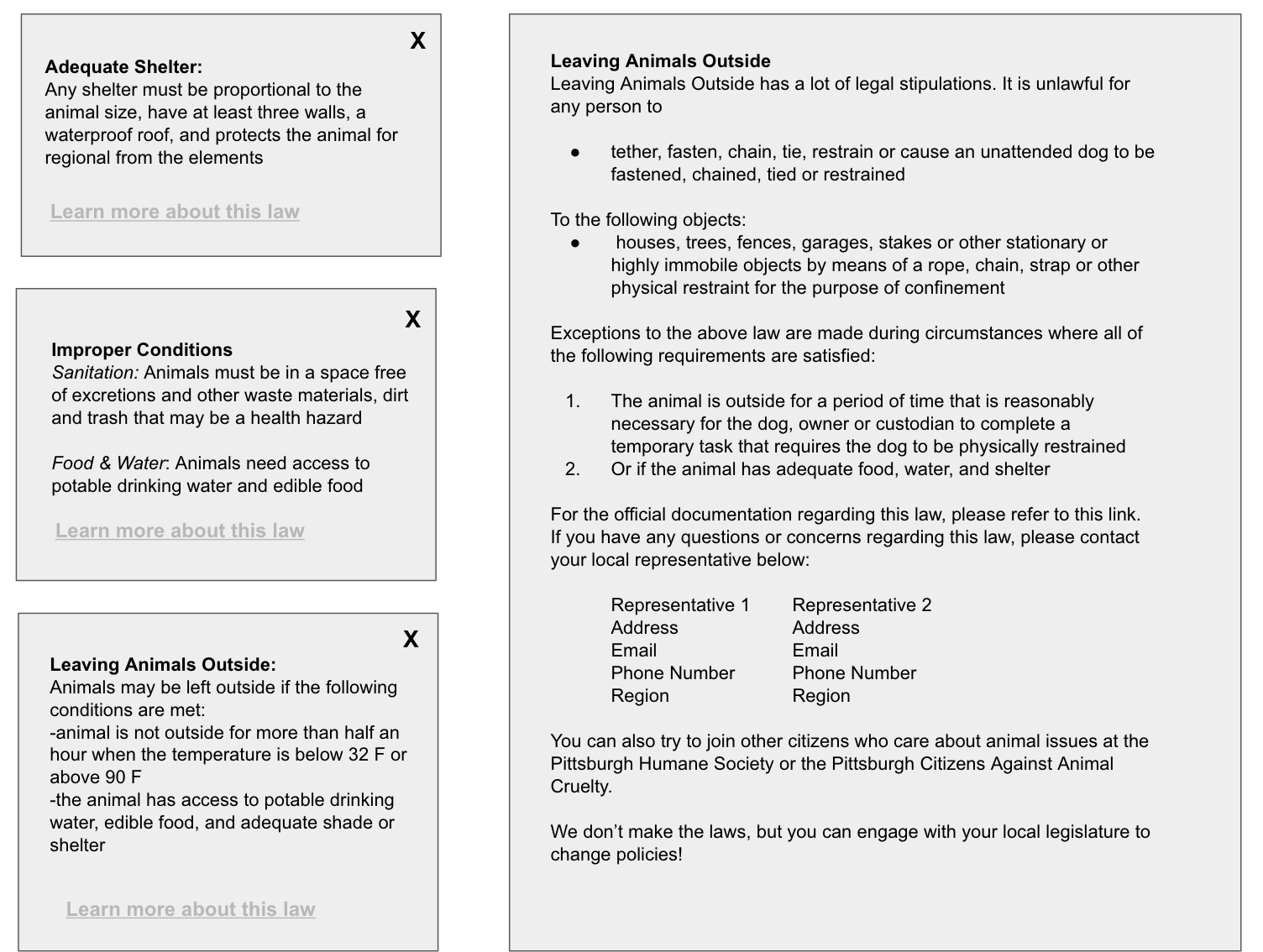ABOUT
Animal Cop is a project aimed at helping officers and citizens report cases deal with cases animal abuse. This work was done for Pittsburgh’s Animal Rescue League, a non-profit animal shelter.
MY ROLES: My main tasks involved identifying design opportunities, communicating insights to clients, and translating research insights into screen design.
MY TEAM: Yiran Buckley, Vanessa Kalu, Sarah Moss-Horwitz, Maggie Yu
TOOLS: Sketch, InVision, Pen & Paper
TIMELINE: January - May 2017
BACKGROUND
Animal shelters provide crucial services to promote animal welfare that include the prosecution and prevention of animal abuse or neglect. However, investigations are complicated.
Concerned, well-meaning citizens get confused, often contact the wrong authority, too late and without the necessary evidence
Staff officers are overwhelmed without this evidence and can't prosecute animal cases the necessary action taking action and successfully prosecuting criminal cases.
We worked with the Humane Animal Rescue shelter to understand how technology could better support animal welfare through a service design framework.
Exploratory research
Primary research goals and interview groups.
We used a variety of methods including a literature review, competitive analysis, and interviews to understand the problem space.
We quickly familiarized ourself with the domain by ding this work. By the end of this process we became well informed about the wild world of in animal laws and humane investigations.
Synthesizing insights
We compiled all of our research by creating an affinity diagram and constructing service models to map out current processes. Based on this work we were able to synthesize five major insights that inform our design process. An in-depth discussion of our process can be found in our final research report.
Workflow diagram for a Humane Officer responding to a case
1. The main goal of animal rescue is to educate.
A humane officer’s primary role is to educate by giving people the resources necessary to care for their animals. Interviewed humane officers all highlighted cases where they gave as many resources to the animal owner as possible, rather than immediately taking the animal.
2a. Misreporting can have serious consequences for the organization, people, and animals involved.
Incomplete information and false information from reports lead to serious drains on the already limited resources of the humane officer. Callers fail to give the appropriate information to asses cases and sometimes maliciously give false information.
2b. Laws are complicated and don’t match people’s assumptions.
Citizens don't know what legally constitutes animal abuse, sometimes reporting cases that aren't abuse. There are multiple layers of laws and current resources are difficult for citizens to find, let alone comprehend.
Cultural model of agents and actors involved in the Pittsburgh animal rescue world
3. Animal Rescue operations are collaborative and co-dependent.
Reporters often provide incomplete information and even false information. This leads to serious drains on the already limited resources of the humane officer.
4. For citizen reporters, lack of feedback after reporting is frustrating and disheartening.
Currently, citizens get no feedback about cases. Without this feedback, citizens become concerned that nothing is being done and question whether their actions have actually helped the situation.
Our team created various diagrams to showcase our own understanding of the problem space and highlight opportunities for our designs to address users’s pain points.
Based on these insights we prioritized designs that:
reduce work for the humane officer
facilitate easier and simpler access to information for citizens
address this problem as a service design issue
ideation
Co-creating imagined futures with our clients
Working off our our insights, we hosted a participatory design session with our clients. This was meant to better understand their goals and to generate a wide variety of ideas. In doing so, we helped our clients learn more about the design process and got their animal expertise in designing potential solutions.
Assumption activity to facilitate co-creation.
Co-creating with our stakeholders and coming up with many design ideas
Testing our hypothesis by speed dating
After coming up with ~20 different of scenarios, we tested our concepts through speed dating sessions with a variety of potential users. We showed storyboard scenarios of potential ideas to 8 different citizens and past reporters. Based on this feedback, we were able to prioritize key features for our solutions.
Establishing our design vision.
We found the opportunity to create a digital solution to address current pain points in the reporting-investigating process. Rather than burdening the animal shelter staff and humane officer staff with dealing with false reports and managing incoming cases, a digital platform could help facilitate citizen's reports and educate them through the process. At the same time, once these reports are sent, a digital platform focused on the humane officer needs could help them with managing their cases.
Design Explorations
Exploring citizen education during the reporting process
We experimented with various ways of designing for both the humane officer and citizen reporter. For the citizen, we explored ways to actually educate them during their reporting process and to guide them through the entire journey of actually reporting a case.
Considering ways to help the Humane Officer with case management
For the Humane Officer, we focused on management systems that would help humane officers organize, find, and view new reports. We focused on a mobile design for this part of the project after learning that most of the humane officers work happens on-the-go when en-route to visiting cases.
Testing & Validation
Throughout the iteration phase, our team made sure to test our designs with appropriate user groups. We recruited regular citizens to test our reporting form and went to stakeholders and experts from the animal shelter to test our humane officer tools.
We used a variety of testing methods including:
task analysis
design walkthroughs
scenario testings
a/b tests
design decisions
Assist the HO in deciding what is most severe and organizing their cases.
Action: Present an itinerary of daily cases, that are easy to rearrange and manage. We programmed automatic "urgency" badges to appear next to cases that fell under certain case categories.
Result: Adding this type of flexibility resulted in HOs feeling like they had a better sense of autonomy and more likely do adopt such a system.
InVision of case management designs for a Humane Officer
Gather richer information for the HO
Action: Information from citizens can sometimes be lacking. We compiled a list of critical questions for citizens to fill out to submit their report.
Result: We noticed that participants gave more information when prompted by the form. With the option to input picture and audio, participants were able to provide information that would be otherwise difficult for them to describe. In having more information inputting through the form, HOs would have a more complete set of information before arriving on-scene.
HTML prototype of our form for submitting and recording case information
Reduce misappropriate reporting
Action: To further weed out reports, we divided the form into two pages. The first page would serve as a screener, re-directing participants to a different screen if their case did not fall under HO jurisdiction.
Result: This flow was more successful at preventing citizens from reaching the form.
Designs and logic flow behind a true and false report
Reflections & NEXT STeps
Handing off designs
For this project, our team delivered a working prototype of the online form. While we were unable to develop a working prototype of the animal cop application, we handed off these designs for a contractor or future CMU HCI team to implement.
The wild world of animal cops
One of the best parts of this experience, was finding opportunities to use design to better a crucial system for animal welfare. This work couldn’t have been done without the help of our stakeholders at the Pittsburgh Animal Shelter and the hard work of my teammates.
Animal Cop was a very unique experience, deep diving into a totally new and unique domain. In talking to various stakeholders and citizens, I got a unique picture into the local animal shelter scene. It was political, difficult, and eye opening in ways that I didn’t anticipate.
A poster from our capstone presentation, summarizing our work.


























